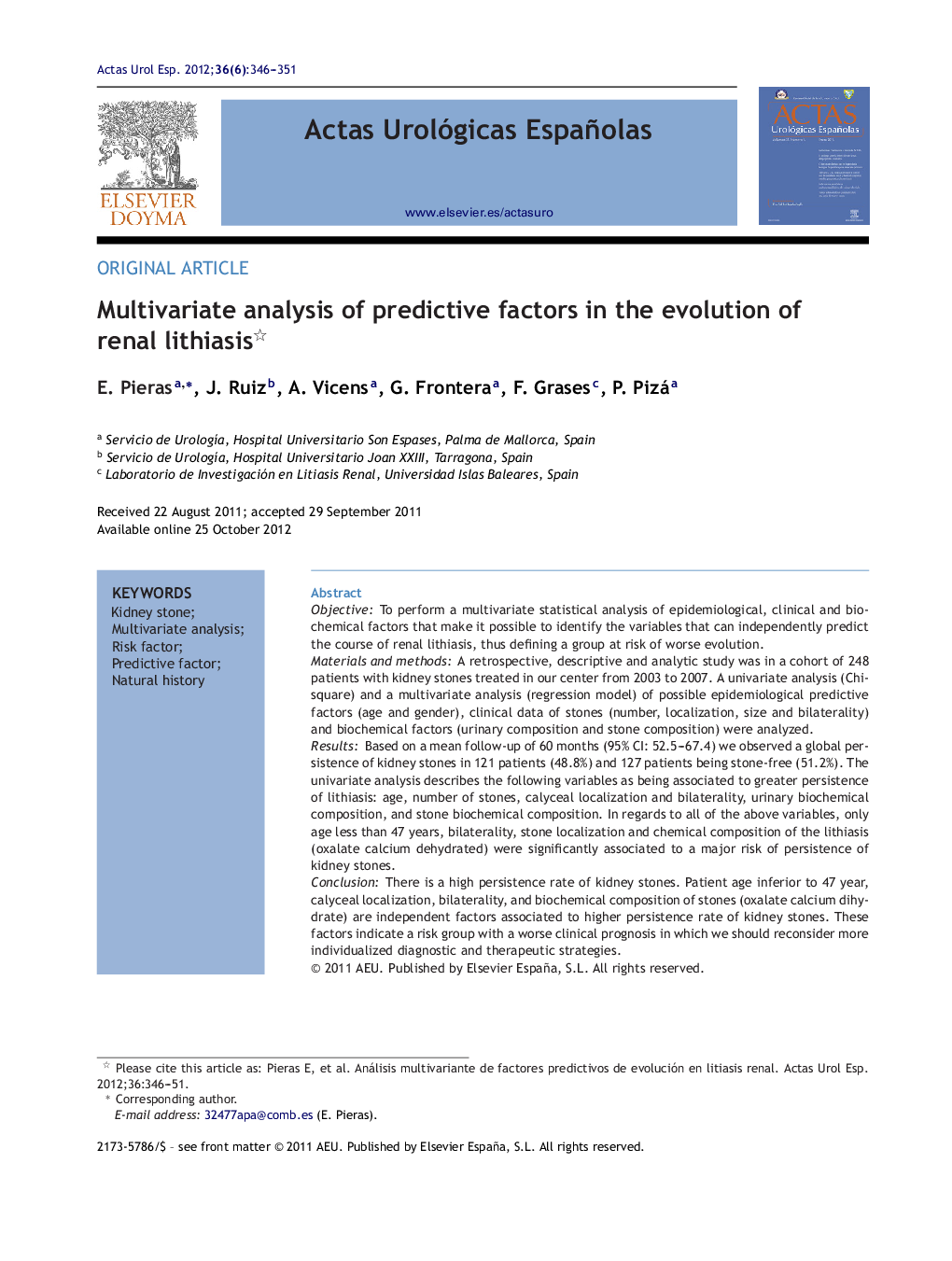| کد مقاله | کد نشریه | سال انتشار | مقاله انگلیسی | نسخه تمام متن |
|---|---|---|---|---|
| 3845713 | 1248287 | 2012 | 6 صفحه PDF | دانلود رایگان |

ObjectiveTo perform a multivariate statistical analysis of epidemiological, clinical and biochemical factors that make it possible to identify the variables that can independently predict the course of renal lithiasis, thus defining a group at risk of worse evolution.Materials and methodsA retrospective, descriptive and analytic study was in a cohort of 248 patients with kidney stones treated in our center from 2003 to 2007. A univariate analysis (Chi-square) and a multivariate analysis (regression model) of possible epidemiological predictive factors (age and gender), clinical data of stones (number, localization, size and bilaterality) and biochemical factors (urinary composition and stone composition) were analyzed.ResultsBased on a mean follow-up of 60 months (95% CI: 52.5–67.4) we observed a global persistence of kidney stones in 121 patients (48.8%) and 127 patients being stone-free (51.2%). The univariate analysis describes the following variables as being associated to greater persistence of lithiasis: age, number of stones, calyceal localization and bilaterality, urinary biochemical composition, and stone biochemical composition. In regards to all of the above variables, only age less than 47 years, bilaterality, stone localization and chemical composition of the lithiasis (oxalate calcium dehydrated) were significantly associated to a major risk of persistence of kidney stones.ConclusionThere is a high persistence rate of kidney stones. Patient age inferior to 47 year, calyceal localization, bilaterality, and biochemical composition of stones (oxalate calcium dihydrate) are independent factors associated to higher persistence rate of kidney stones. These factors indicate a risk group with a worse clinical prognosis in which we should reconsider more individualized diagnostic and therapeutic strategies.
ResumenObjetivoRealizar un análisis estadístico multivariante de factores epidemiológicos, clínicos y bioquímicos que permitan identificar las variables que independientemente puedan predecir la evolución de la litiasis renal, definiendo así un grupo de riesgo con peor evolución.Material y métodosEstudio analítico, descriptivo, retrospectivo sobre 248 pacientes visitados en nuestro centro en el periodo 2003-2007. Se ha realizado análisis univariante (Chi-cuadrado) y multivariante (regresión logística) de posibles factores predictivos epidemiológicos (sexo, edad), clínicos (antecedentes personales de litiasis, número, localización caliciar y tamaño de cálculos, bilateralidad) y bioquímicos (bioquímica urinaria y composición del cálculo) en relación con la evolución de la litiasis renal (limpio o persistencia renal).ResultadosCon un seguimiento medio de 60 meses (IC 95% = 52,5-67,4) observamos una persistencia global de litiasis renal en 121 pacientes (48,8%), estando limpios de litiasis 127 pacientes (51,2%). El análisis univariante describe como variables asociadas a mayor persistencia de litiasis la edad, el número de litiasis, la localización calicilar, la bilateralidad, la composición bioquímica urinaria y la composición bioquímica del cálculo; de todas estas variables, en el análisis multivariante solo mantienen significación estadística la edad inferior a 47 años, la bilateralidad, la localización calicilar y la composición química de la litiasis (oxalato cálcico dihidrado).ConclusionesExiste una elevada persistencia de litiasis renal. La edad inferior a 47 años, la bilateralidad, la localización calicilar y la composición química de la litiasis (oxalato cálcico dihidrato) son factores asociados a mayor persistencia de litiasis renal de forma independiente. Estos factores señalan un grupo con peor evolución clínica, en los que deberíamos replantear estrategias diagnósticas y terapéuticas más individualizadas.
Journal: Actas Urológicas Españolas (English Edition) - Volume 36, Issue 6, June 2012, Pages 346–351